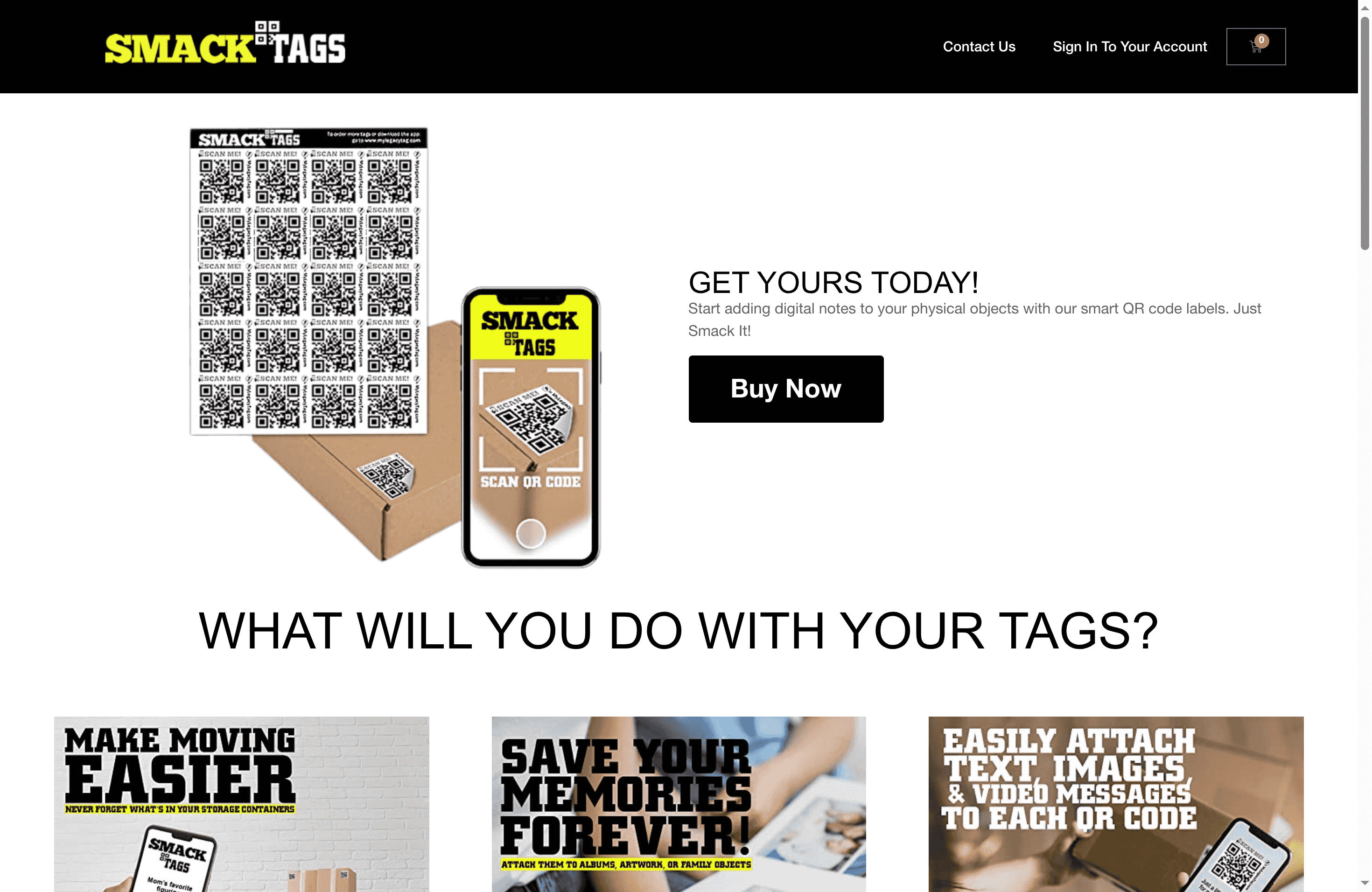Complete Guide to Why Use Scannable Labels
Every day, over 6.8 billion QR codes are scanned worldwide, showing just how quickly these tiny squares have changed the way people access and share information. Whether you want to preserve precious memories or manage business inventory, bridging physical and digital worlds is more valuable than ever. Understanding how scannable labels and QR codes work can open up new ways to organize, protect, and interact with the things that matter most to you.
Table of Contents
- Understanding Scannable Labels And QR Codes
- Key Features And How Labels Work
- Personal And Business Use Cases Explained
- Comparing Scannable Labels To Alternatives
- Critical Considerations: Security And Cost
Key Takeaways
| Point | Details |
|---|---|
| Versatility of Scannable Labels | Scannable labels bridge the gap between physical and digital realms, enhancing memory preservation, business inventory management, and educational resources. |
| Enhanced Information Storage | Unlike traditional barcodes, scannable labels support extensive data types and allow for dynamic updates, making them far more versatile. |
| Security Considerations | Users must verify the source of scannable labels to protect against potential security vulnerabilities, including phishing attacks. |
| Cost-Benefit Analysis | While initial costs may be higher, the long-term savings through operational efficiency and reduced error rates can justify the investment in smart labeling technology. |
Understanding Scannable Labels and QR Codes
Imagine holding a small sticker that can instantly connect you to a world of digital information. That’s exactly what scannable labels and QR codes offer – a seamless bridge between physical objects and digital content. According to Wikipedia, QR codes are two-dimensional barcodes that store data in intricate black-and-white square patterns, enabling quick information access through smartphone scanning.
These smart labels represent more than just simple tags. Wikipedia explains that smart labels integrate advanced technologies like RFID and QR codes into traditional labeling systems, dramatically expanding their functionality. They transform ordinary stickers into powerful information carriers that can track, store, and instantly share data about an item’s history, instructions, or personal memories.
The magic of scannable labels lies in their versatility. They can serve multiple purposes across different domains:
- Personal Memory Preservation: Attach digital stories to family heirlooms
- Business Inventory Management: Track items with instant digital documentation
- Educational Resources: Link additional learning materials to physical objects
- Art and Creative Projects: Provide background information or artist statements

By combining physical and digital worlds, scannable labels offer an innovative way to add depth, context, and interactivity to everyday items. Whether you’re an artist wanting to share your creative process or a business looking to streamline information management, these smart labels provide a simple yet powerful solution.
Key Features and How Labels Work
Scannable labels are technological marvels that transform simple stickers into powerful information portals. Wikipedia reveals that these codes can store multiple data types, including numeric, alphanumeric, byte/binary, and even kanji characters, with impressive error correction capabilities that ensure readability even if the label is partially damaged.
The underlying technology is remarkably sophisticated. According to Wikipedia, smart labels integrate a complex system combining a transponder, chip, and antenna within a seemingly simple label. This intricate design enables remarkable functionalities like automated reading and data transmission across various distances, making these labels far more than just traditional stickers.
Key features of scannable labels include:
- Versatile Data Storage: Capable of holding text, URLs, contact information, and multimedia content
- Error Resilience: Can maintain data integrity even with partial damage
- Quick Scanning: Instant information retrieval using smartphones
- Compact Design: Small physical footprint with extensive digital capabilities
For artists, crafters, and business professionals, these labels offer an innovative way to bridge physical and digital realms. By embedding rich digital content into a tiny sticker, explore our Smack Tag solution to transform how you store, share, and interact with your most cherished items and important information.
Personal and Business Use Cases Explained
Scannable labels have revolutionized how individuals and organizations manage and share information. Wikipedia highlights their versatility, noting that these codes are extensively utilized in marketing, product tracking, and mobile payments, offering consumers rapid access to services and information across multiple domains.
In the business world, smart labels have become an essential tool for operational efficiency. Wikipedia explains that these innovative labels are particularly powerful in logistics and supply chain management, enabling real-time tracking and sophisticated inventory management that transforms traditional business processes.
Here are some compelling use cases across personal and professional contexts:
Personal Applications:
- Family History Preservation: Attach digital memories to family heirlooms
- Art Portfolio Management: Link background stories to artwork pieces
- Travel Memories: Create interactive scrapbooks and photo collections
- Personal Collections: Document and track collectibles with detailed histories
Business Applications:
- Inventory Tracking: Monitor product movements and stock levels
- Equipment Management: Record maintenance histories and warranties
- Asset Documentation: Create digital records for valuable business resources
- Customer Engagement: Provide additional product information and multimedia content
By bridging physical and digital worlds, scannable labels offer an innovative solution for storing, sharing, and accessing information. Whether you’re an individual preserving memories or a business optimizing operations, explore our Smack Tag solutions to unlock new possibilities of digital connection and information management.
Comparing Scannable Labels to Alternatives
Wikipedia reveals a significant technological evolution in data tracking and information storage. Traditional one-dimensional barcodes have severe limitations, storing minimal data and requiring direct line-of-sight scanning. In contrast, scannable labels like QR codes represent a quantum leap in information technology, offering two-dimensional data storage with dramatically enhanced capabilities.
Smart label technologies have fundamentally transformed tracking and information management. According to Wikipedia, these advanced labels incorporating RFID technologies provide remarkable advantages over traditional identification methods, such as the ability to be read from a distance and store significantly more complex data. This technological sophistication means businesses and individuals can now capture and retrieve information with unprecedented ease and flexibility.
Comparing different labeling technologies reveals clear advantages of scannable labels:
![]()
Here’s a comparison of traditional alternatives and scannable label advantages:
| Feature | Traditional Methods | Scannable Labels |
|---|---|---|
| Information Storage | Limited Static |
Extensive Dynamic |
| Data Types Supported | Text only Basic codes |
Text URLs Multimedia |
| Updating Information | Manual Time-consuming |
Digital Instant updates |
| Scanning Requirements | Line-of-sight Special hardware |
Smartphones Remote scan |
| Error Resilience | Prone to loss or damage | Built-in error correction |
Traditional Alternatives:
- Paper Labels: Static, limited information storage
- Handwritten Tags: Prone to errors, difficult to update
- Basic Barcodes: Restricted scanning, minimal data capacity
- Manual Tracking: Time-consuming and error-prone
Scannable Label Advantages:
- Dynamic Information: Easily updatable digital content
- Extensive Data Storage: Multimedia, text, links supported
- Remote Scanning: Quick information retrieval
- Error Resilience: Maintains data integrity
To experience the next generation of smart labeling, explore our Smack Tag 20 Pack and revolutionize how you track, share, and interact with your most important items.
Critical Considerations: Security and Cost
Wikipedia warns that while scannable labels offer incredible convenience, they also introduce potential security vulnerabilities. Malicious actors can embed harmful codes that potentially lead to phishing attacks or unexpected malware downloads, making it crucial for users to exercise caution and verify the source of any scanned label.
The economic landscape of smart labeling is equally complex. Wikipedia highlights that implementing advanced label technologies involves higher upfront costs due to the sophisticated integration of tracking and data storage technologies. However, the long-term benefits often outweigh these initial investments, providing enhanced operational efficiency and detailed information management.
Key Security and Cost Considerations:
Security Precautions:
- Source Verification: Always scan labels from trusted sources
- Device Protection: Use updated antivirus software
- Limited Information Sharing: Control what data gets embedded
- Regular Label Audits: Periodically review and update labels
Cost-Benefit Analysis:
- Initial Investment: Higher than traditional labeling methods
- Long-Term Savings: Reduced manual tracking expenses
- Operational Efficiency: Faster information retrieval
- Error Reduction: Minimized human error in data management
For those seeking a balance between security, affordability, and functionality, explore our Smack Tag 20 Pack designed with user protection and value in mind.
Unlock the Full Potential of Scannable Labels for Your Personal and Business Needs
Many people struggle with keeping track of important items and memories while wanting a simple way to share detailed information quickly. The article highlights the power of scannable labels to connect physical objects with rich digital content like videos, notes, and images. This solves the common challenge of cumbersome manual tracking and lack of context for everyday items, family heirlooms, or business assets.
Smack Tags offers an easy, durable solution that matches every pain point discussed. Our smart QR code labels are fade resistant and water resistant, so your valuable data stays safe over time. You do not need any special apps to use them, making it simple for anyone to create a visual inventory or streamline business processes. Whether you want to preserve stories tied to personal treasures or improve inventory management for work, these labels bring your goals to life in seconds.
Experience the convenience and security of smart labeling for yourself. Visit the Uncategorized – Smack Tags page to explore options that fit your specific needs.

Start organizing and sharing your world with Smack Tags today. Head to https://smacktags.com to get your set and see how easy it is to transform your belongings into connected stories and efficient systems. Don’t wait because every moment you delay means lost stories or missed opportunities for better management.
Frequently Asked Questions
What are scannable labels and how do they work?
Scannable labels are technological labels, like QR codes, that link physical items to digital information. They work by storing data in two-dimensional barcodes, which can be quickly scanned using a smartphone for easy access to information about the item.
What are the key features of scannable labels?
Key features of scannable labels include versatile data storage options, error resilience, quick scanning capability using smartphones, and a compact design that combines extensive digital functionality in a small physical footprint.
How do scannable labels compare to traditional barcodes?
Unlike traditional barcodes that only store limited data and require line-of-sight scanning, scannable labels can hold extensive information, including multimedia content and URLs, and can be scanned remotely, enhancing usability and data management.
What security precautions should I take when using scannable labels?
To ensure safety, verify the source of any scanned label, use updated antivirus software on your device, limit the amount of information shared through the codes, and conduct regular audits to review and update existing labels.
